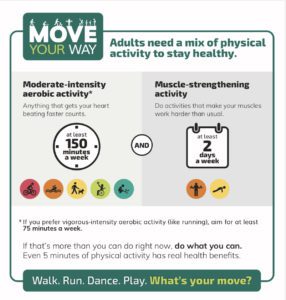
Did you know that strength training can boost your health and fitness, especially as you age. So why not include it?
Strength training, also known as resistance training, is activities that use resistance to induce muscular contraction. This type of specialized training includes dumbbells, resistance bands, weight machines, and even your body weight, according to the U.S. Department of Health and Human Services (HHS).
The new Physical Activity Guideline for Americans from HHS recommends children and adolescents ages 6 through 17 should incorporate strength training into their daily 60 minutes of physical activity three days per week. Adults should do strength training activities at a minimum of 2 or more days a week.

Source: U.S. Government Health and Human Services
Studies show that strength training provides many benefits, such as improving lean muscle mass, elevating balance capabilities, building back lost muscle tissue, improving cardiovascular health, increasing metabolic rate, improving bone density, and reducing the risk of injury that commonly occurs with aging. It also enhances energy and mood-boosting capabilities.
Improves strength and muscle tone
Although the benefit may be obvious, don’t overlook that muscle strength is crucial in doing day-to-day activities, especially as we get older and lose muscle mass.
There are two types of strength training, and both should be a part of a well-rounded routine:
- Isometric exercises involve contracting muscles against a nonmoving object such as pushups against the floor
- Isotonic exercises involve movement through a range of motion, such as lifting weights
Builds lean muscle mass and protects bone health
According to research, we start losing lean muscle mass, starting at the age of 30 at the rate of 3 to 5 percent per year. According to a study published in the Journal of Bone and Mineral Research (2017), 30 minutes twice a week of high-intensity resistance and impact training was shown to improve bone density, bone structure, and strength in postmenopausal women with low bone mass.
Improves Balance and Coordination
Strength training helps develop better body mechanics. Older people are at risk of falling because of worsening physical functioning, but strength training can improve posture and reduce the risk of falling incidents.
Increases metabolism and keeps weight off
Although I love endurance sports and cardio workouts, I have found that adding resistance training to my routine has helped me shed more weight and keep it off. Exercise scientists suspect that strength training increases your resting metabolism, which means your body continues to burn calories after you stop exercising.
Improve Chronic disease maintenance
Many documented studies show strength training has many wellness benefits, including improving chronic diseases such as arthritis pain. Also, strength training has been shown to improve glucose control, which is advantages for those that are pre-diabetic or type 2 diabetics.
Boost energy and improves mood
Research has shown that exercise, in general, can elevate endorphins, which lift energy levels and improve mood. Still, according to a study in BMC geriatrics, there were some promising results in terms of strength training and reduction in depression during a six months intervention group. Also, other research reveals that strength training has a positive effect on neurochemical and brain neuromuscular responses.
Rest days are required to build muscle
It’s important to remember that strength training requires rest and recovery days. Your muscles get stronger and rebuild muscle tissue during the rest period, not during the actual workout. So when incorporating strength training, remember to do it every other day or work different muscle groups to provide your muscles the rest they need.
Now, who doesn’t want to feel better, look better, or live a healthier life? Well, what are you waiting for?
If you have health issues or health risk, ask your doctor what type of strength training is best to meet your needs and abilities. You can also check with your local fitness expert to help get you started. I hope you found this article interesting. Let me know what type of strength training you have tried.
Sources:
The Benefits of strength training for older adults – American journal of preventive medicine 25, 141-149 2003; R. Seguin, M. Nelson
Increasing Lean Mass and Strength: A Comparison of High-Frequency Strength Training to Lower Frequency Strength Training – International Journal of Exercise Science 9(2) 159-167, 2016; M. Thomas, S. Burns
Physical Activity Guidelines for Americans 2nd Edition – U.S. Department of Health and Human Services (HHS)
Journal of Bone and Mineral Research, October 2017
Exploring the feasibility of a community-based strength training program for older people with depressive symptoms and its impact on depressive symptoms – BMC geriatrics (2006) – J.Sims, K. Hill, S. Davidson, J. Gunn, N. Huang









Great article thank you Dr Darlene! ????????????
I’m glad you enjoyed it Kitty
Helpful Article Dr. Darlene.
Thank you Eugen